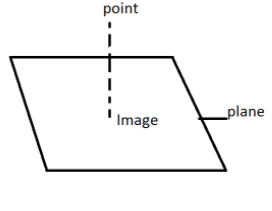Question
Question: In the projection of point \[P(\mathop p\limits^ \to )\]on the plane\[\mathop r\limits^ \to .\mathop...
In the projection of point P(p→)on the planer→.n→=q is the points S(s→), then
Solution
The projection of a point is its shadow on the plane or central projection.
If C is a point, called the centre of projection then the projection of a point P different from C onto a plane that does not contain C is the interaction of the line CP with the plane.

Complete step-by- step solution:

Let us draw a plane and the projection of point P(p→)on the plane is s→.
The intersection is r→.n→=q
As the line is normal to the plane i.e. perpendicular to the plane and vector P→ is passing through the plane and parallel to n→
Eqn of such a line isr=p+λn……...(1)
Given, r→.n→=q........(2)
As the line is passing through the plane, then the equation (1) will be satisfying equation (2) and that point r→=s→
Substituting equation (1) in (2), we get:
⇒ (p→+λn→)n→=q
To find the value of λ, simplify the above term then we get it as
⇒p→.n→+λn→.n→=q
As [n.n=n→2] , we get:
⇒λn→2=q−p→.n→
⇒λ=n→2q−p→.n→______ (3) {On RHS n→2 will be in division as it was multiplication on LHS}
Now using equation (3) in (1), we get:
r→=p→+(n→2q−p→.n→)n→
We know thatr=s, hence:
s→=p→+(n→2q−p→.n→)n→
Note: Two planes are parallel if they have the same normal vector (i.e. their normal vectors are parallel). If two planes are not parallel, then they intersect in a line.If any line passes through a plane then it always satisfies the equation of that plane.
